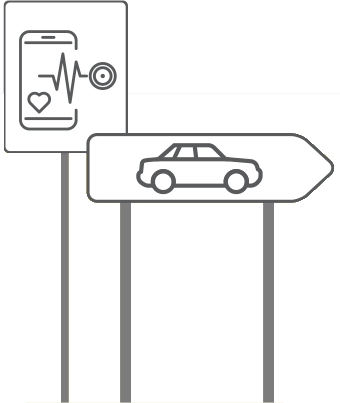While patient transportation networks are already well established, more and more health systems are integrating rideshare services such as Lyft and Uber into their transportation programs, hoping to increase network coverage, reduce patient no-shows to improve compliance with their care, and decrease program costs.
There is no shortage of case studies that have spoken to the benefits of providing rideshare services in the healthcare setting. But what are some specific considerations on how this model can be successfully integrated within a workers’ compensation transportation offering?

An estimated 3.6 million Americans miss medical appointments each year due to a lack of transportation.1 It’s well-understood that delaying medical treatment can cause short- and long-term impacts, such as exacerbated health concerns that lead to higher medical and overall program costs.
From an injured worker’s perspective, a missed appointment may mean the difference between getting the green light from the doctor to return to work – or delaying it even further. Therefore, patient access to reliable transportation becomes a key component of driving positive health outcomes.
While traditional patient transportation services help many patients, rideshare models present opportunities to alleviate some of the pain points associated with traditional sedan services and enhance the value that transportation programs offer to patients and payers alike.
 Network Coverage.
Network Coverage.When traditional transportation networks experience a shortage of drivers, or when available drivers are overbooked, unavailable, or rendered unable to make a pickup, rideshare services can offer a larger pool of drivers to utilize. From a geographic perspective, network coverage can be a challenge in rural or less-populated areas for traditional networks, and rideshare networks can help fill in the gaps.
 Costs for payers.
Costs for payers.Traditional sedan transportation services can become costly when including factors such as rush fees and wait times, factors that are greatly reduced with rideshare services.
There is also the cost of a missed medical appointment due to transportation delays to consider. All of these add up to a substantial bill for the payer, when the patient has not received any care or service that will improve their health or return-to-work status. An increase in network coverage from rideshare models could help prevent missed appointments, leading to more opportunities to save.
 Scheduling flexibility.
Scheduling flexibility.In healthcare, time is of the essence. There are many situations related to a patient’s care that may be unplanned or unexpected. While rush scheduling is a component of traditional transportation services, it comes at significant cost.
The flexible, on-demand rideshare model can augment traditional sedan transportation in this capacity. Rideshare services employ millions of drivers across the country, offering a large driver network that can routinely provide reliable transportation. This network is typically available 24/7/365, and these rides are significantly less expensive than most patient transportation services.
One of the most significant barriers to patient transportation, the financial barrier, is not typically a concern in workers’ comp claims as patients rarely pay out-of-pocket for claim-related services. Patient no-shows are instead driven by other factors, which might include miscommunications, a lack of patient motivation, or other forms of nonadherence to care. This makes creating a better patient experience and driving higher patient engagement critical to any transportation model.
Rideshare models are driven heavily by user feedback via rating systems, which incentivizes service providers (in this case, Lyft or Uber drivers) to provide an exceptional rider experience, which can include anything from the cleanliness of the vehicle, the friendliness of the driver, and even extra touches such as complimentary water bottles.
In the healthcare setting, this experience is made even easier for the injured worker rider. Compared with the non-patient rider, injured workers bear no responsibility for scheduling or payment – all of this is seamlessly handled on the back end as it is through traditional transportation services.

In the various reports released by health programs that have partnered with rideshare services, there was an almost unanimous agreement that rideshare improved patient satisfaction and reduced transportation complaints. One company reported a 50% reduction in transportation complaints,2 while others reported increases in patient satisfaction ranging from 28-47%.3,2 In one case, patient satisfaction reached 81% as the result of rideshare inclusion.4
While the inclusion of rideshare services can bolster workers’ comp transportation programs, offering benefits for payers and patients alike, rideshare services also come with considerations. Due to factors such as patient accommodation and legislation, rideshare can augment but cannot completely replace traditional transportation.
Unlike traditional sedan transportation services that require significant notice due to smaller networks, rideshare services can connect users with drivers almost instantaneously. This results in:
More rides – in New York City alone, Lyft arranges 2,500 rides per week for a single healthcare client3
Shorter wait times – for certain clients, rideshare companies have reduced wait times by 30-34%4,2
Fewer no-shows – pilot programs that integrated rideshare reduced no-shows by 27%5
The elimination of rush fees and driver wait fees
Rideshare services record metrics for every ride taken, documenting cost, ride distance, duration, route and more. Furthermore, GPS tracking provides the ability to monitor ride progress in real-time, allowing stakeholders to verify if a patient is on their way to their appointment. These features reduce opportunities for fraud, waste, and abuse.
There is a significant opportunity for payers to experience a reduction in transportation spend by supplementing their programs with the rideshare model, due to factors that include lower trip costs, reduced or eliminated rush charges, and capped wait times. Savings from 20-40% have been reported,2,4,6 although this can vary depending upon patient populations and geographies.
Rideshare can also generate savings beyond transportation costs alone. Greater adherence to medical appointments and fewer delays in care help drive improved recovery, reduced need for additional medical services, and quicker return to work. These improved patient outcomes translate into medical and indemnity cost savings for the payer.
The connective nature of rideshare applications allows for real-time monitoring of patient transports, giving stakeholders timely insight into any issues facilitating a ride. This creates the ability for stakeholders to manage concerns in a timelier fashion compared with traditional patient transportation models where stakeholders may be alerted of transportation issues well after the concern has occurred.
Rideshare services primarily cater to individuals with little-to-no mobility issues and is not suitable to those who need assistance getting in and out of vehicles. Furthermore, rideshare vehicles and their drivers are not equipped to provide care.
While rideshare companies have launched pilot programs that connect wheelchair-bound patients with modified vehicles and allow drivers to receive independent training from third parties to offer riders assistance getting in and out of vehicles, these programs have not been implemented on a broad scale, and more information is necessary to understand their feasibility.
Furthermore, from a legal standpoint, even if rideshare services could offer further assistance, whether they legally can or have the liability coverage to do so is another question entirely.
Rideshare legislation has come a long way in the last few years as most states have legalized these services, creating incredible diversity in state-to-state regulation. Healthcare programs that wish to implement these services must ensure compliance with local laws.
One point of note is that 46 states and territories have set insurance coverage rules and standards for rideshare companies.7 Companies like Lyft and Uber typically offer $1 million in liability coverage, and rideshare companies do have policies in place to minimize potential risks through driver screenings. However, in scenarios that involve a patient as the rider, additional liability coverage is favorable, which can be attained through strategic partnerships, including through workers’ comp transportation networks, which can yield liability coverage in excess of $5 million.
 As telemedicine programs are increasingly implemented in workers’ comp, some have argued that virtual appointments could reduce the need for patient transportation. While telemedicine does offer significant benefits – such as access to care for patients in rural or far-to-reach areas, or for patients who face severe mobility issues – the choice between telemedicine and transportation should be decided on a case-by-case basis.
Depending on a patient’s injury, having patients meet with doctors or physical therapists in person may be more impactful, and the simple act of leaving the home could be beneficial for patients, as isolation and a stationary lifestyle do not bode well for recovery.
As telemedicine programs are increasingly implemented in workers’ comp, some have argued that virtual appointments could reduce the need for patient transportation. While telemedicine does offer significant benefits – such as access to care for patients in rural or far-to-reach areas, or for patients who face severe mobility issues – the choice between telemedicine and transportation should be decided on a case-by-case basis.
Depending on a patient’s injury, having patients meet with doctors or physical therapists in person may be more impactful, and the simple act of leaving the home could be beneficial for patients, as isolation and a stationary lifestyle do not bode well for recovery.